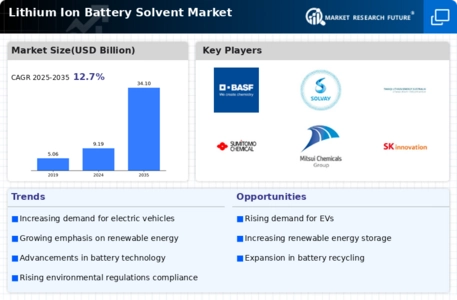Technological Innovations
Technological innovations play a pivotal role in shaping the Lithium Ion Battery Solvent Market. Advancements in solvent formulations and production processes are enhancing the efficiency and safety of lithium-ion batteries. For instance, the introduction of high-performance solvents has improved energy density and cycle life, making batteries more competitive in various applications. The market is witnessing a surge in investments aimed at developing next-generation solvents that can withstand higher temperatures and improve overall battery performance. As these innovations continue to emerge, they are likely to drive growth in the Lithium Ion Battery Solvent Market, with projections indicating a potential increase in market size by approximately 15% over the next five years.
Sustainability Initiatives
The Lithium Ion Battery Solvent Market is experiencing a notable shift towards sustainability initiatives. As environmental concerns intensify, manufacturers are increasingly adopting eco-friendly solvents in battery production. This transition is driven by regulatory pressures and consumer demand for greener products. The market for sustainable solvents is projected to grow significantly, with estimates suggesting a compound annual growth rate of over 10% in the coming years. Companies are investing in research and development to create solvents that minimize environmental impact while maintaining performance. This focus on sustainability not only enhances brand reputation but also aligns with global efforts to reduce carbon footprints, thereby propelling the Lithium Ion Battery Solvent Market forward.
Growing Consumer Electronics Sector
The growing consumer electronics sector is a significant driver of the Lithium Ion Battery Solvent Market. With the proliferation of smartphones, laptops, and wearable devices, the demand for high-performance batteries is on the rise. Lithium-ion batteries are favored for their lightweight and high energy density, making them ideal for portable electronics. Market analysts predict that the consumer electronics market will continue to expand, potentially reaching a valuation of over 1 trillion dollars by 2026. This growth directly correlates with an increased need for lithium-ion batteries, thereby boosting the demand for solvents used in their production. As manufacturers strive to meet consumer expectations for longer battery life and faster charging times, the Lithium Ion Battery Solvent Market is poised for substantial growth.
Rising Demand from Electric Vehicles
The Lithium Ion Battery Solvent Market is significantly influenced by the rising demand from electric vehicles (EVs). As the automotive sector shifts towards electrification, the need for efficient and reliable battery solutions has surged. This trend is expected to continue, with forecasts indicating that the EV market could reach over 30 million units sold annually by 2030. Consequently, the demand for lithium-ion batteries, and by extension, the solvents used in their production, is anticipated to rise sharply. Manufacturers are responding to this demand by optimizing solvent compositions to enhance battery performance and longevity, thereby driving growth in the Lithium Ion Battery Solvent Market.
Increased Investment in Renewable Energy
Increased investment in renewable energy sources is contributing to the expansion of the Lithium Ion Battery Solvent Market. As countries strive to transition to cleaner energy systems, the demand for energy storage solutions is escalating. Lithium-ion batteries are integral to this transition, as they provide the necessary storage capacity for renewable energy sources such as solar and wind. The market is witnessing a surge in funding for battery technology development, with investments projected to exceed several billion dollars in the next few years. This influx of capital is likely to enhance the production capabilities and innovation within the Lithium Ion Battery Solvent Market, fostering a more robust and competitive landscape.

























Leave a Comment